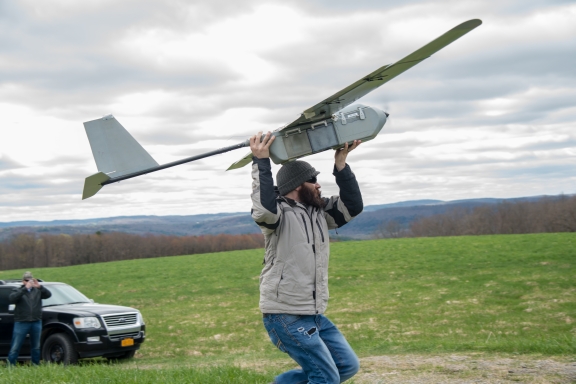Releases

“Envision a small, handheld cargo aircraft– a simple air vehicle with huge payload potential.”
OWEGO, New York, May 22, 2019 – The Air Force Research Lab’s (AFRL) Advanced Power Technology Office (APTO) estimates that typical long endurance group 1 unmanned aerial systems’ (UAS) flight time lasts two hours on average. A system’s endurance, along with its payload capacity, often means life or death for the special operations forces who use them to complete a multitude of missions.
That’s why AFRL worked with Lockheed Martin [NYSE: LMT] to mature and enhance a developmental platform called Condor eXtended Endurance and Payload (XEP). Previously Condor was similar to other Group 1 systems, with a two-hour maximum of flight endurance and a standard payload bay.
AFRL and Lockheed Martin overcame a series of engineering hurdles to not only improve the system’s endurance but also optimize the fuselage to accommodate multiple payload types.
For endurance, the team integrated a high energy-density battery and field-oriented controller to generate optimal phasing in the motor – doubling its endurance to up to four hours of continuous flight on a single battery.
For the fuselage, they redesigned the structure, so Condor can easily accommodate up to two, 6-inch payloads, uncommon for the average Group 1 UAS. It also features built-in power and communications, so an operator can add a gimbal or other non-traditional payloads.
“Envision a small, handheld cargo aircraft – a simple air vehicle with huge payload potential,” said Ryan Gagnon, program manager for Lockheed Martin’s Small Unmanned Aerial Systems team. “Couple that with increased endurance, now special forces, especially small tactical units, can have group 2 UAS capabilities in a more portable and affordable solution.”
In addition to long endurance and customizable payload options, Condor has several key features, including:
- Marinized air vehicle, EO/IR gimbal, avionics, motor, etc. for sea landing
- Modular and open architecture to prevent any vendor lock-in;
- Low acoustic signature for virtually soundless operations; and
- Flight-capable in all weather conditions, including heavy rains.
“The Lockheed Martin and AFRL partnership has provided a field-ready, user-ready, highly advanced Group 1 SUAS.” said Ed Clark, Aviation program lead at AFRL. “This vehicle is now an industry leader.”
In April 2019, the AFRL APTO office completed the acceptance test demonstration of the Condor XEP at Lockheed Martin’s Owego, New York facility. This concludes the advanced development program. However, AFRL and Lockheed Martin plan to make additional efficiency gains by integrating a hydrogen fuel cell later in the year.
To learn more about Lockheed Martin’s autonomous systems like Condor XEP, visit lockheedmartin.com/unmanned. For more information on AFRL APTO, email afrl.rxsc.apto@us.af.mil.
About AFRL
The Air Force Research Laboratory's (AFRL) mission is to discover, develop, and integrate affordable warfighting technologies for air and space forces. AFRL accomplishes this through nine technology directorates, the Air Force Office of Scientific Research, and Headquarters staff. AFRL Headquarters and five directorates are co-located at Wright-Patterson Air Force Base. AFRL is a full-spectrum laboratory, responsible for planning and executing the Air Force's entire science and technology budget, basic and applied research, and advanced technology development.
About Lockheed Martin
Headquartered in Bethesda, Maryland, Lockheed Martin is a global security and aerospace company that employs approximately 105,000 people worldwide and is principally engaged in the research, design, development, manufacture, integration and sustainment of advanced technology systems, products and services.

